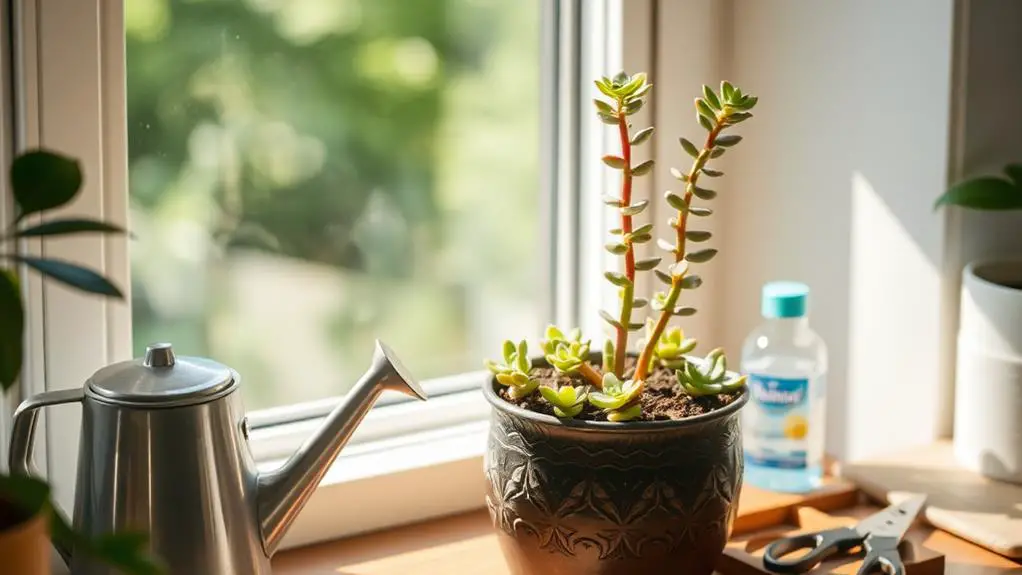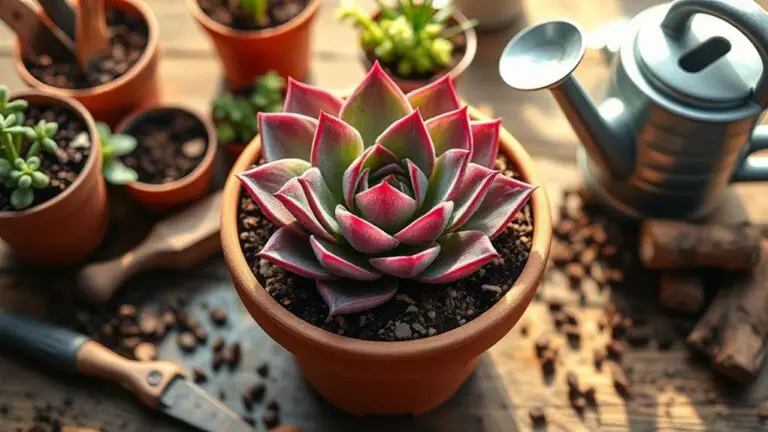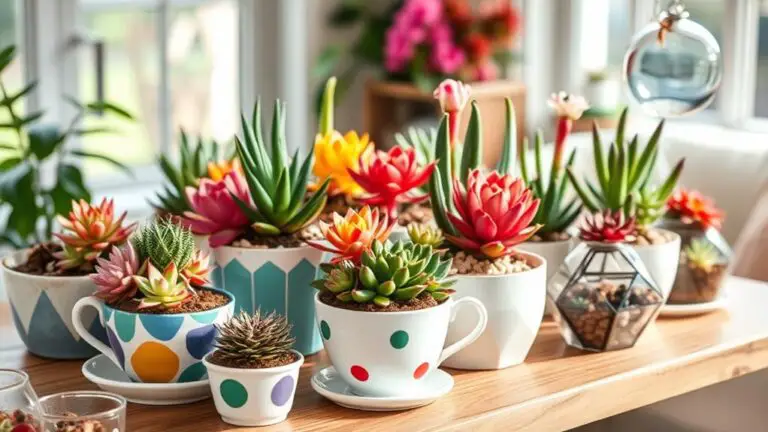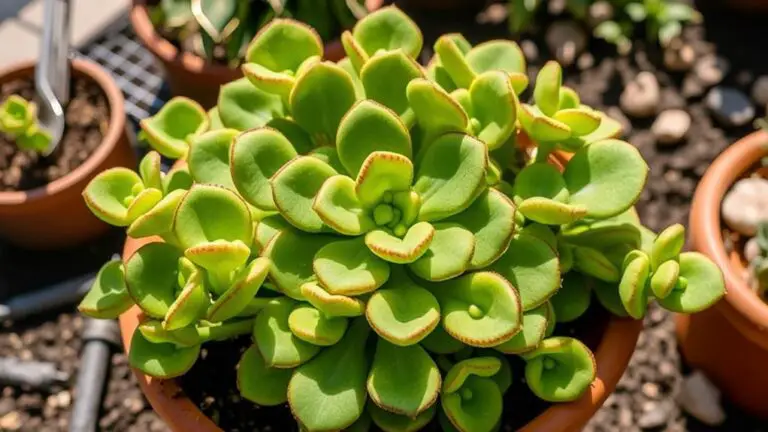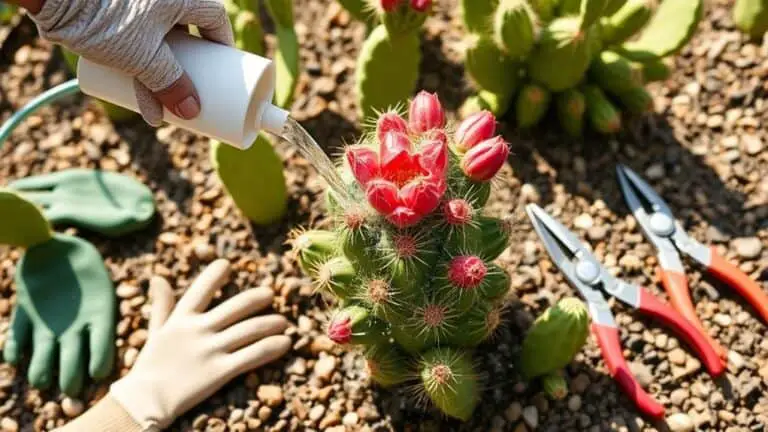10 Steps to Care for Your Crassula Baby Necklace
Caring for your Crassula Baby Necklace can be straightforward if you follow the right steps. Start by understanding its light needs—placing it near a bright, south-facing window is essential, but you'll want to avoid harsh afternoon rays. The soil choice is equally important; opt for a well-draining mix to prevent root rot. Water sparingly, ensuring the soil dries out completely between waterings. But what about the ideal temperature and humidity levels? And how do you handle pruning or pest problems? Stick around, and you'll find out exactly how to keep your succulent thriving.
Understanding Light Requirements
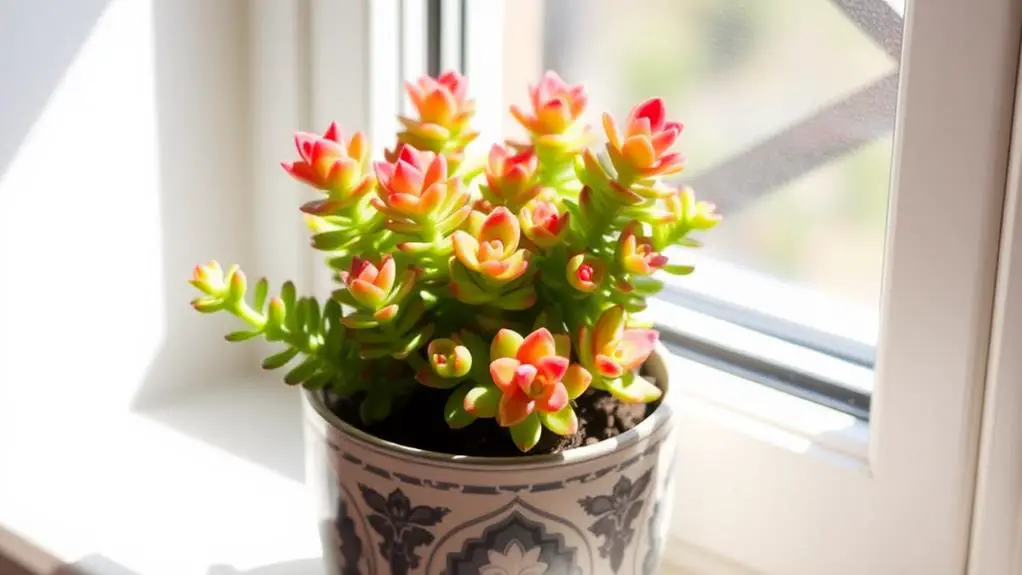
Understanding the light requirements for your Crassula Baby Necklace Variegata is crucial for its thriving growth.
Place your Crassula near a bright, sunny window, ideally less than one foot from a south-facing window, to guarantee it gets maximum light exposure. Morning sunlight is perfect, but avoid the harsh afternoon sun to prevent leaf burn.
Monitor your plant's health by checking for symptoms of stress like yellowing or drooping leaves, which indicate too much or too little light. Balanced exposure promotes healthy growth and blooming.
Adjust the placement based on seasonal changes to maintain ideal conditions. Light shade in the evening can also be beneficial.
Proper light management is key for your Crassula's health and well-being.
Choosing the Right Soil
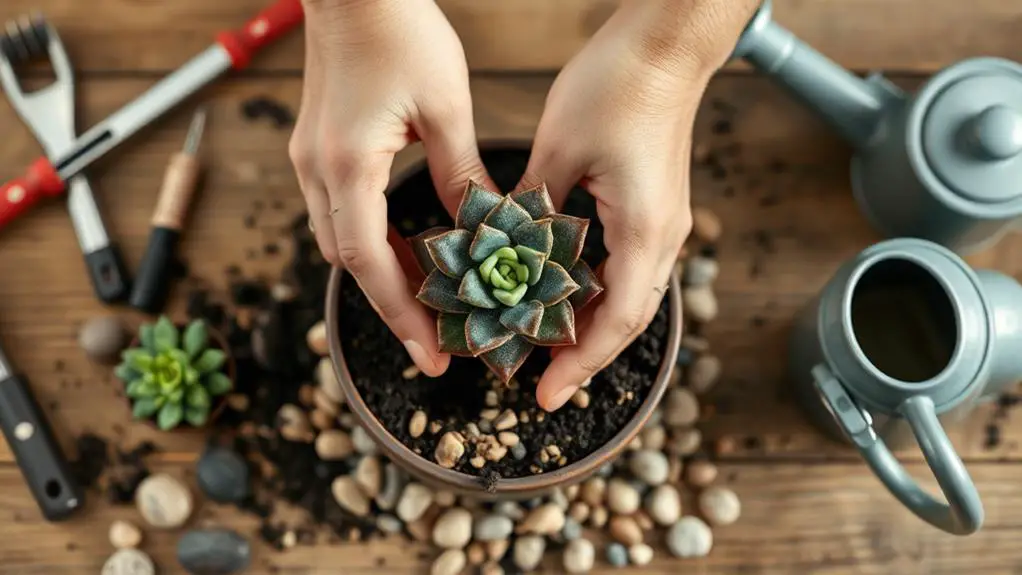
Choosing the right soil for your Crassula Baby Necklace is essential to its health and growth.
Use a well-draining potting mix with perlite or vermiculite to guarantee proper drainage and avoid wet soil problems.
Make sure the soil is porous and granular, promoting good airflow and preventing root rot.
Optimal Soil Composition
When it comes to cultivating a healthy Crassula Baby Necklace, the potting mix plays a crucial role. You'll need well-draining soil to prevent moisture accumulation, which can cause root rot. A mix with perlite or vermiculite enhances drainage and aeration, keeping your plant happy. Make certain the soil composition is porous and has high granular content. This type of potting mix allows the soil to dry out between watering sessions, minimizing the risk of root rot. Regularly repotting your Crassula Baby Necklace with fresh soil prevents nutrient depletion and keeps your plant thriving. Avoid heavy, moisture-retaining soil types that can suffocate the roots.
| Soil Component | Benefit |
|---|---|
| Perlite | Enhances drainage |
| Vermiculite | Improves aeration |
| Porous Mix | Prevents water accumulation |
| Granular Soil | Guarantees soil dries out |
| Fresh Soil | Prevents nutrient depletion |
Drainage and Aeration
Guaranteeing proper drainage and aeration is paramount when caring for your Crassula Baby Necklace.
Choose well-draining soil, like a mix with perlite or vermiculite, to enhance aeration and prevent root rot. Always use a pot with drainage holes to stop water from pooling at the roots. This helps avoid fungal diseases.
Regularly replace the potting soil to keep nutrients fresh and maintain good aeration. When repotting, pick a soil designed for succulents; it supports their drought-resistant nature.
Keep an eye on moisture levels—let the soil dry out completely between waterings. This balance guarantees your Crassula Baby Necklace stays healthy and vibrant.
Proper Watering Techniques

For ideal health, it's important to water your Crassula Baby Necklace sparingly. This plant thrives when you let the soil dry out completely between waterings.
During the growing season, water thoroughly with about 0.5 cups every 12 days. In winter, reduce the frequency to every three weeks.
Always make certain your pot has good drainage to prevent root rot. You don't want standing water that can cause fungal diseases.
Check the soil moisture level by touching the top inch; if it's dry, it's time to water. Be cautious in winter, as cold, wet soil can damage roots.
Adjust your watering schedule based on the season, humidity, and temperature to guarantee proper care.
Ideal Temperature Conditions
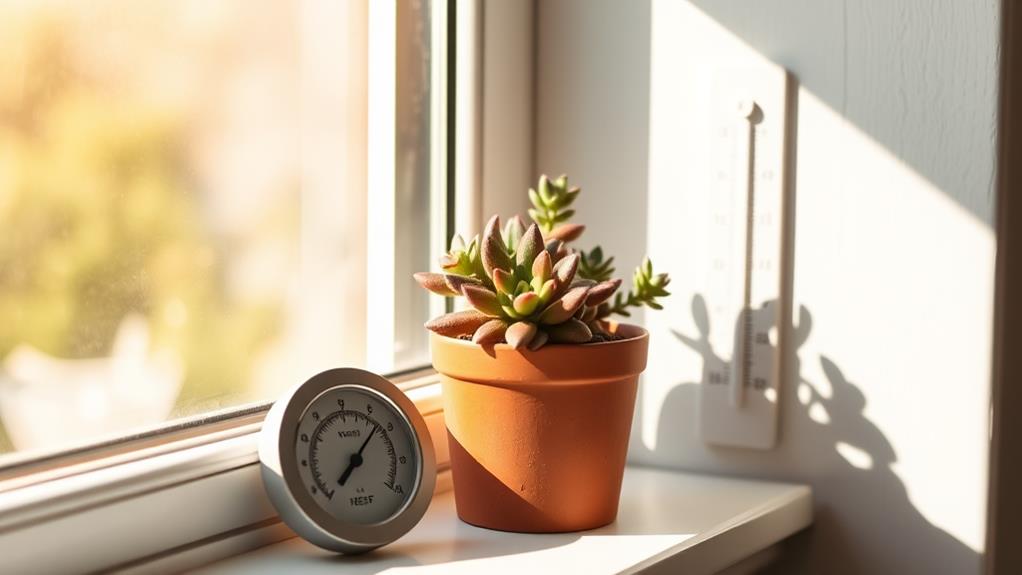
After mastering proper watering techniques, it's time to focus on the ideal temperature conditions for your Crassula Baby Necklace.
For peak growth, keep summer temperatures between 65°F and 70°F. During winter, the plant can handle temperatures as low as 50°F, but you must avoid frost damage.
Maintaining a stable temperature is vital since fluctuations can stress the plant. To prevent this, consider indoor placement during cold months.
Consistent temperature control promotes healthy growth and helps prevent issues like root rot. Remember, extreme temperatures can harm your Crassula Baby Necklace, so it's important to monitor conditions closely.
Managing Humidity Levels

To keep your Crassula Baby Necklace healthy, make sure it's in an environment with average household humidity.
If your home gets very dry, especially in winter, consider using a humidifier to help.
Just be careful not to overdo it, as too much humidity can cause root rot and other issues.
Optimal Humidity Range
When caring for your Crassula Baby's Necklace, understanding the ideal humidity range is key to guaranteeing its vibrant growth. This plant thrives in average household humidity levels, typically from 30% to 50%.
Maintaining moderate humidity is essential because excessive moisture can lead to root rot. Regularly monitor humidity levels to avoid issues like drooping leaves. During dry months, a humidifier can help maintain favorable conditions.
Confirm your Crassula Baby Necklace is in a well-ventilated area to manage humidity effectively. Adequate airflow helps prevent fungal diseases, keeping your plant healthy.
Using a Humidifier**
Although Crassula Baby's Necklace can adapt to varying humidity levels, using a humidifier can greatly boost its health and growth. Aim to maintain humidity levels around 40-60% to prevent leaf curling and other stress symptoms.
Place your humidifier at a safe distance to avoid excess moisture on the leaves, which can lead to rot. Regular monitoring is key, especially during dry winter months.
Pairing the humidifier with proper air circulation creates an ideal environment for your Crassula Baby Necklace. This combination supports its vibrant growth and unique aesthetic.
Fertilizing Your Crassula
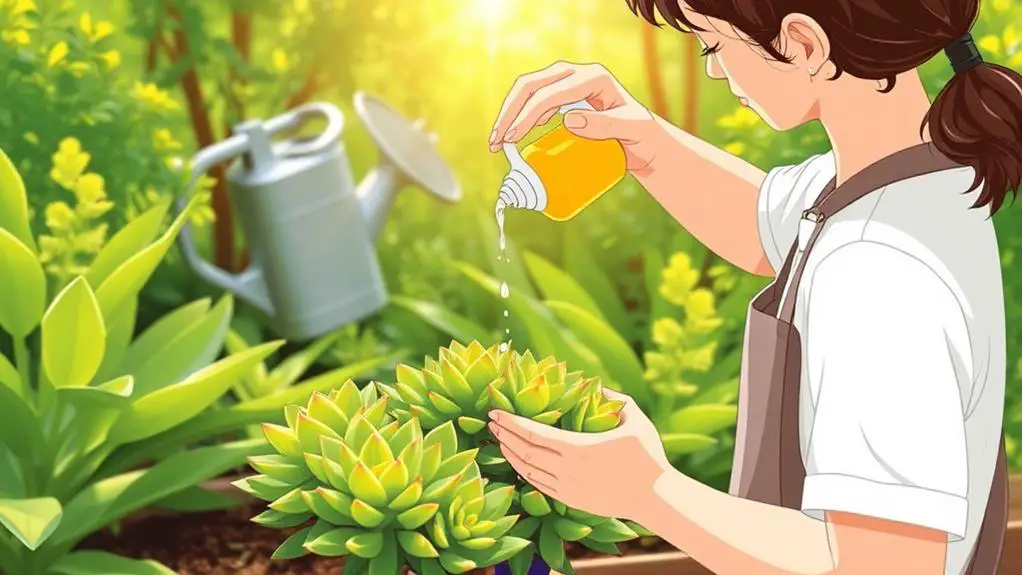
While Crassula Baby Necklace Variegata generally thrives without additional fertilization, you might choose to give it a nutrient boost during the growing season. This can support ideal health and growth.
Since most potting soils provide sufficient initial nutrients, fertilizing should be done sparingly. Monitor your plant for signs of nutrient depletion, such as stunted growth. These signs may indicate the need for repotting or fresh potting soil.
When repotting, choose well-draining soil to prevent root rot. Fresh potting soil will replenish nutrients, reducing the need for frequent fertilization.
Pruning and Shaping
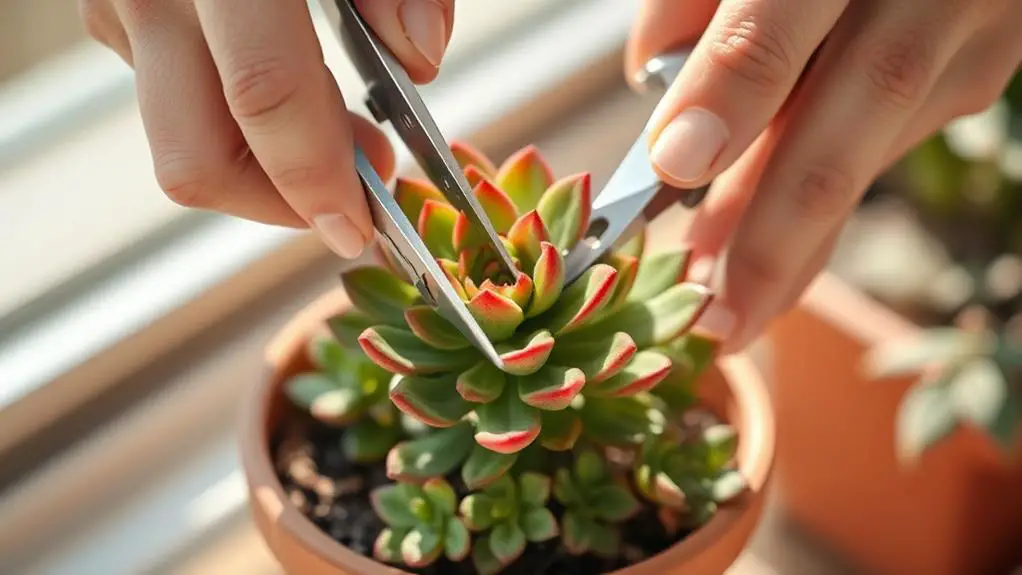
Fertilizing isn't the only way to keep your Crassula Baby Necklace in top shape; pruning and shaping play an essential role too.
Start by pruning in early spring or late winter to encourage new growth. Use clean, sharp scissors or pruning shears to remove dead leaves, ensuring a clean cut.
Trim overgrown stems just above a leaf node to control height and promote bushier growth. Regularly check for leggy growth and trim it back for a fuller appearance.
After pruning, let the cuttings callus for a few days before replanting them in well-draining soil to prevent rot.
Pruning not only keeps your plant healthy but also enhances its beauty, making it a delightful addition to your space.
Identifying Common Pests

Pests can be a real nuisance for your Crassula Baby Necklace, causing significant damage to its leaves and overall health. Common culprits include mealybugs, aphids, and spider mites. Look out for sticky residue, webbing, and discoloration on the leaves. Regularly inspect the undersides of leaves and stem joints, as pests often hide there. If you spot any, treat your plant with insecticidal soap or neem oil, making sure to cover all affected areas. Maintaining good air circulation and avoiding overcrowding can help keep pests at bay.
| Pest | Signs |
|---|---|
| Mealybugs | Sticky residue |
| Aphids | Discoloration |
| Spider mites | Webbing |
| All | Deformities in leaves |
| All | Found on leaf undersides |
Stay vigilant, and your plant will thrive!
Propagating New Plants
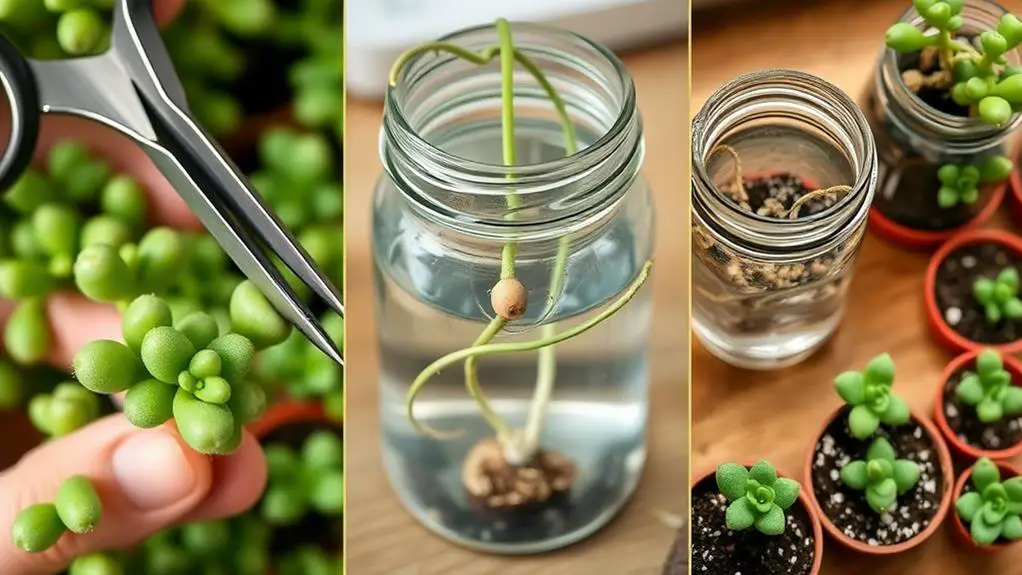
Propagating new Crassula Baby Necklace plants is a straightforward and rewarding process. Start by taking cuttings from healthy stems, each about 2-4 inches long with a few leaves attached.
Let the cuttings dry and callus for 1-2 days to prevent rot. Next, place them in moderately moist, well-draining soil.
Make sure they get bright light, preferably filtered sunlight, to promote root growth without burning the leaves. Water sparingly, waiting until the soil is dry to the touch before re-watering, usually every 1-2 weeks, depending on environmental conditions.
After a few weeks, once roots have formed, transfer the new plants to individual pots with succulent soil for ideal health. Enjoy watching your Crassula Baby Necklace thrive!
Seasonal Care Adjustments

When caring for your Crassula Baby Necklace, it's important to adjust your watering schedule and light exposure based on the season.
In summer, make sure the plant gets morning sunlight but shield it from intense afternoon rays to prevent leaf burn.
During winter, water less frequently, about every three weeks, as the plant's growth slows down and it needs drier conditions.
Watering Schedule Changes
Adjusting your watering schedule for the Crassula Baby Necklace is essential to its health and vigor.
During summer, water your plant about once a week, ensuring the soil dries out between waterings to prevent root rot. In winter, reduce the water frequency to roughly once every three weeks, as the plant enters dormancy and needs less moisture.
Always check soil moisture before watering; dry soil in the top 1-2 inches means it's time to water. Adjust your watering schedule based on environmental humidity. Drier conditions may require more frequent watering, while higher humidity might mean less.
Overwatering can cause yellowing or mushy leaves, so monitor closely during seasonal changes to avoid excess moisture.
Follow these steps, and your Crassula Baby Necklace will thrive!
Light Requirements Shift
Guaranteeing proper light exposure for your Crassula Baby Necklace is essential, especially when traversing seasonal changes.
Place your plant near a south-facing window, ideally less than one foot away, for ideal light intake. During winter, reposition it to get more direct sunlight since natural light levels decrease.
Monitor weather conditions; if it's cloudy or rainy, adjust placement to maximize light exposure. Be mindful of afternoon sun, which can scorch the leaves, and provide partial shade if necessary.
Regularly inspect your plant for signs of light deficiency like stunted growth or yellowing leaves. These signs mean you should adjust placement to guarantee your Crassula Baby Necklace remains healthy and vibrant throughout the year.
Frequently Asked Questions
How to Care for a Crassula Baby Necklace?
Place your Crassula Baby Necklace near a south-facing window for bright light. Water sparingly, letting soil dry out between waterings. Use well-draining soil, monitor temperature, and check for distress signs to keep it healthy.
How to Take Care of Crassula?
Place your Crassula near a south-facing window for bright, direct sunlight. Water sparingly, letting the soil dry out completely. Use well-draining potting mix. Maintain temperatures between 65-70°F. Watch for yellowing or drooping leaves.
Why Is My Baby Necklace Succulent Turning Brown?
Your Baby Necklace succulent's leaves are turning brown due to overwatering, insufficient light, environmental stress, or fungal issues. Confirm the soil dries out between waterings, place it near a south-facing window, and maintain consistent temperatures.
How to Care for Jade Necklace Plants?
Place your jade necklace plant near a south-facing window for bright light. Water sparingly, letting the soil dry out between waterings. Use well-draining soil and repot annually with fresh nutrients for healthy growth.
Conclusion
Caring for your Crassula Baby Necklace doesn't have to be tricky. With the right light, soil, and watering, you'll see it thrive. Keep an eye on temperature and humidity, prune for shape, and watch out for pests. Don't forget to adjust your care routine with the seasons. This way, your plant will stay healthy and happy. Follow these steps, and you'll be a confident, successful gardener in no time. Happy growing!

